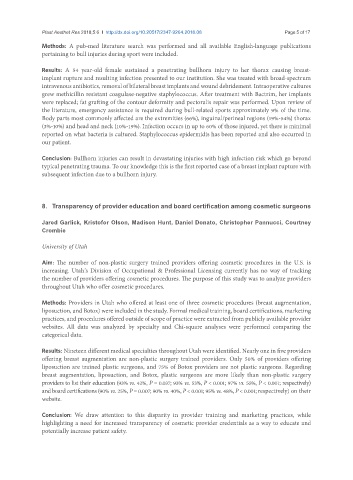Page 53 - Read Online
P. 53
Plast Aesthet Res 2018;5:6 I http://dx.doi.org/10.20517/2347-9264.2018.08 Page 5 of 17
Methods: A pub-med literature search was performed and all available English-language publications
pertaining to bull injuries during sport were included.
Results: A 54 year-old female sustained a penetrating bullhorn injury to her thorax causing breast-
implant rupture and resulting infection presented to our institution. She was treated with broad-spectrum
intravenous antibiotics, removal of bilateral breast implants and wound debridement. Intraoperative cultures
grew methicillin resistant coagulase-negative staphylococcus. After treatment with Bactrim, her implants
were replaced; fat grafting of the contour deformity and pectoralis repair was performed. Upon review of
the literature, emergency assistance is required during bull-related sports approximately 9% of the time.
Body parts most commonly affected are the extremities (66%), inguinal/perineal regions (19%-54%) thorax
(3%-10%) and head and neck (10%-19%). Infection occurs in up to 60% of those injured, yet there is minimal
reported on what bacteria is cultured. Staphylococcus epidermidis has been reported and also occurred in
our patient.
Conclusion: Bullhorn injuries can result in devastating injuries with high infection risk which go beyond
typical penetrating trauma. To our knowledge this is the first reported case of a breast implant rupture with
subsequent infection due to a bullhorn injury.
8. Transparency of provider education and board certification among cosmetic surgeons
Jared Garlick, Kristofor Olson, Madison Hunt, Daniel Donato, Christopher Pannucci, Courtney
Crombie
University of Utah
Aim: The number of non-plastic surgery trained providers offering cosmetic procedures in the U.S. is
increasing. Utah’s Division of Occupational & Professional Licensing currently has no way of tracking
the number of providers offering cosmetic procedures. The purpose of this study was to analyze providers
throughout Utah who offer cosmetic procedures.
Methods: Providers in Utah who offered at least one of three cosmetic procedures (breast augmentation,
liposuction, and Botox) were included in the study. Formal medical training, board certifications, marketing
practices, and procedures offered outside of scope of practice were extracted from publicly available provider
websites. All data was analyzed by specialty and Chi-square analyses were performed comparing the
categorical data.
Results: Nineteen different medical specialties throughout Utah were identified. Nearly one in five providers
offering breast augmentation are non-plastic surgery trained providers. Only 50% of providers offering
liposuction are trained plastic surgeons, and 75% of Botox providers are not plastic surgeons. Regarding
breast augmentation, liposuction, and Botox, plastic surgeons are more likely than non-plastic surgery
providers to list their education (93% vs. 42%, P = 0.037; 93% vs. 53%, P < 0.001; 97% vs. 55%, P < 0.001; respectively)
and board certifications (90% vs. 25%, P = 0.007; 90% vs. 40%, P < 0.001; 95% vs. 48%, P < 0.001; respectively) on their
website.
Conclusion: We draw attention to this disparity in provider training and marketing practices, while
highlighting a need for increased transparency of cosmetic provider credentials as a way to educate and
potentially increase patient safety.

